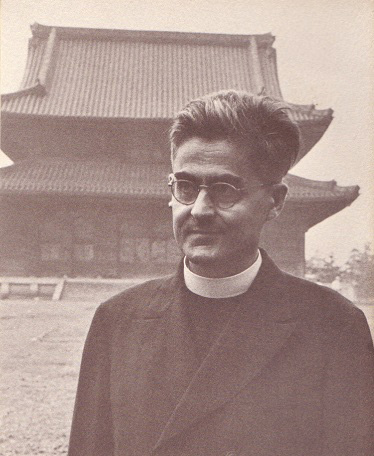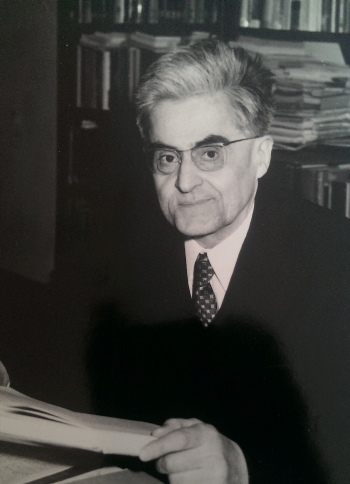ZEN MESTEREK ZEN MASTERS
« Zen főoldal
« vissza a Terebess Online nyitólapjára

Heinrich Dumoulin, S.J. (1905-1995)
Born in 1905, Heinrich Dumoulin was one of the world's foremost Zen scholars. He was Professor Emeritus of Sophia University in Tokyo and founder of its Institute for Oriental Religions, as well as the first Director of the Nanzan Institute for Religion and Culture. He died in 1995 at the age of 90.
http://nirc.nanzan-u.ac.jp/en/staff/heinrich-dumoulin/
http://nirc.nanzan-u.ac.jp/nfile/2314
PDF: Early Chinese Zen Reexamined: A Supplement to Zen Buddhism: A History
Japanese Journal of Religious Studies, 1993 20/1
In German: Eine Neubetrachtung des frühen chinesischen Zen: https://drive.google.com/file/d/0B7mxGepKrr8IUno2YXFRemRHZEU/
PDF: The Person in Buddhism: Religious and Artistic Aspects
Japanese Journal of Religious Studies, 1984 1 112-3
PDF: Zen Enlightenment: Origins and Meaning (1979, Weatherhill)
PDF: Zen Buddhism in the Twentieth Century (1992)
PDF: A History of Zen Buddhism, tr. by Paul Peachey, Pantheon Books, 1963, 335 p.
PDF: Zen Buddhism: A History; Volume 1 India and China, tr. by James W. Heisig and Paul Knitter, World Wisdom, 2005, 440 p.
PDF: Zen Buddhism: A History; Volume 2 Japan, tr. by James W. Heisig and Paul Knitter, World Wisdom, 2005, 520 p.
Table of Contents for Zen Buddhism
Volume 1 India and China
Foreword to the English Edition
• Foreword to the 1988 Edition
• Prologue to the 1988 Edition
• Linguistic Conventions
• Preface
• Note to the 2005 Edition by James W. Heisig
• Introduction by John R. McRae
Part One: Beginnings and Roots in India
1. Sâkyamuni, the Enlightened One
- The Figure of the Buddha
- The Great Experience
- The Transmission of Enlightenment
- The Zen Buddhist View of Sakyamuni
2. The Yogic Element in Buddhism
- Essential Characteristics of Yoga
- The Practice of Meditation in Indian Buddhism Nirvana:
- The Final Goal of the Buddhist Way
- The Roots of Zen in Yoga
3. The Essentials of Mahayana
- The Beginnings of Mahayana
- The Bodhisattva Ideal
- Buddhology
- The History of Mahayana Buddhism
4. The Mahayana Sutras and Zen
- The Spiritual and Intellectual Context of Zen
- The Sûtras of Perfect Wisdom
- Prajnâpâramitâ
- The Doctrine of Totality—Avatarpsaka (Hua-yen)
Part Two: Origins and Blossoming in China
5. Preparations in Chinese Buddhism
- The Historical Understanding of Zen
- The Reception of Buddhism in China
- Kumârajiva and the School of the "Middle Way"
- Seng-chao Tao-sheng
6. The Early Period Bodhidharma-History and Legend
- The Image of Bodhidharma in Zen History
- Hui-k'o and Seng-ts'an Tao-hsin and Hung-jen
7. The Split between the Northern and Southern Schools
- The "Suddenness" of the South and "Gradualness" of the North
- The Northern School
- The Claim of the Southern School
- The Ox-Head School
8. The Sutra of the Sixth Patriarch
- The Tun-huang Text and its Sources
- The Biography of Hui-neng
- Sudden Enlightenment as Seeing into One's Nature
- The Mahâyâna Doctrines of No-Mind and the Buddha Nature
9. The Zen Movement after Hui-neng
- The Beginnings of the "Zen of the Patriarchs" Schools and Currents
- The Two Main Lines of Chinese Zen
- Strange Words and Extraordinary Actions Monastic Life
10. Lin-chi
- The Generational Line From the Life of Lin-chi
- Themes from the Rinzairoku
- Lin-chi and His School
11. Characteristics of the Five Houses
- The Persecution of Buddhism
- The "Five Houses"
- Kuei-yang: Experience in Action
- Lin-chi: Threefold and Fourfold Formulas Ts'ao-tung:
- "The Five Ranks" Yun-men: "The One-Word Barriers"
- Fa-yen: The Interpenetration of Attributes
12. The Sung Period: A Time of Maturation
- Zen and the Spirit of the Age
- Kôan Practice and Kôan Collections
- Aspects of the Kôan Method
- The Two Mainstreams of Zen
13. Developments in Culture and Society
- The "Five Mountains" and "Ten Temples"
- Zen Buddhism and the Neo-Confucians
- Zen Art Syncretistic Tendencies and Decline
• Epilogue
• Supplement: The Northern School of Chinese Zen
• Appendix I : Abbreviations
• Appendix 2: Chronological Table
• Appendix 3: Chinese Characters
• Appendix 4: Genealogical Tables
Index of Names and Titles
Index of Terms and SubjectsVolume 2 Japan
Foreword to the 1990 Edition
Note to the 2005 Edition by James W. Heisig
Introduction by Victor Sogen Hori
The Zen Schools in JapanSection 1: The Planting of Zen In Japan
1. The Rinzai School in the Kamakura Period
- Early History Background to the Kamakura Period
- Dainichi Nõnin and the Daruma School
- Eisai
- Eisai's Disciples
- Enni Ben'en
- Shinchi Kakushin
- Chinese Masters
- The Rinzai School Prior to the End of the Kamakura
- Period
2. Dogen
- Life and Work
- Essential Characteristics
- Zen Master and Religious Thinker
3. The Soto School after Dogen
- Dogen and His Disciples
- Koun Ejo
- The Dispute over the Third-Generation Successor
- Keizan JokinSection 2: Expansion and Achievement to the End of the
- Middle Ages4. The Five Mountains to the Rinzai School
- The Establishment and Reinforcement of the System
- National Teacher Muso
- The Movement of the Five Mountains during the
- Muromachi Period
5. The Rinka Monasteries
- Daitoku-ji and its Founder Kanzan Egen and the Myoshin-ji Line
- Ikkyp Spjun
- The Genjo Line Rural Rinzai Monasteries
- The Expansion of the Soto School
6. Zen in Art and Culture
- Architecture
- Garden Art
- Calligraphy
- Painting
- The Spread of Tea Culture
- Related ArtsSection 3: The Zen Movement during the Modern Period
7. The Beginnings of Japan's Modern Period
- The Periods of Azuchi (1568-1582) and Momoyama (1582-1600)
- The First Encounters between Zen and Christianity
- The Edo Period and Zen
- Takuan Soho
8. The Zen Schools during the Tokugawa Period
- The Obaku School
- The Rinzai School before Hakuin The Soto School
- An Excursus on Basho and Zen's Love of Nature
9. Hakuin
- Life and Enlightenment Experiences The Zen Sickness
- Koan Practice before and after Enlightenment
- Working among the People
- Hakuin's Disciples and Hakuin's Zen
10. Modern Movements
- The Zen Schools in the New Order of the Meiji Period
- Masters of the Rinzai School
- Adjustments within the Soto School
- Opening to the WestEpilogue
Appendix 1 : Abbreviations
Appendix 2: Chronological Table
Appendix 3: Chinese Characters
Appendix 4: Genealogical Tables
Bibliography
Chinese and Japanese Sources
Works in Western Languages
Index of Names and Titles
Index of Terms and Subjects
Bibliography (more books in English)
The Development of Chinese Zen After the Sixth Patriarch in the Light of the Mumonkan (1953, First Zen Institute of America)
Christianity Meets Buddhism (1974, Open Court Publishing)
Buddhism in the Modern World (1976, Macmillan Publishing)
![]()
Werke (Auswahl)
Wu-men-kuan ... Der Pass ohne Tor / Übersetzt und erklärt von Heinrich Dumoulin, S.J / Tôkyô: Sophia University Press (Jôchi Daigaku), 1953 (Monumenta Nipponica monographs. no. 13), 64 p.
Buddhismus der Gegenwart. Hrsg. von Heinrich Doumoulin. Herder, Freiburg etc. 1970.
Östliche Meditation und christliche Mystik. Verlag Karl Alber, Freiburg i. Br. / München 1966
Geschichte des Zen-Buddhismus. Band I: Indien, China und Korea. Angkor Verlag, Frankfurt am Main 2010.
Geschichte des Zen-Buddhismus. Band II: Japan. Angkor Verlag, Frankfurt am Main 2010.
Heinrich Dumoulin: Mumonkan. Die Schranke ohne Tor. Angkor Verlag, Frankfurt am Main 2010, (Reprint)

Heinrich Dumoulin: Geschichte des Zen-Buddhismus.
Band I: Indien, China, Korea.
Band II: Japan.
(Neuauflage angekündigt im Francke/Narr Verlag mit neuen Texten!)
Zu der vorigen Ausgabe des Angkor Verlages gibt es noch diese Ergänzungen:
Schriftzeichen zu Band I (pdf) Schriftzeichen zu Band II (pdf)
Traditionstafeln Band I (pdf) Traditionstafeln Band II (pdf)
Bibliografie zu Band I+II (pdf)
![]()
PDF: Mit adhat nekünk a buddhizmus? (Interjú)
In: Mérleg, Herder, Bécs, 1974/2. 113-121. oldal